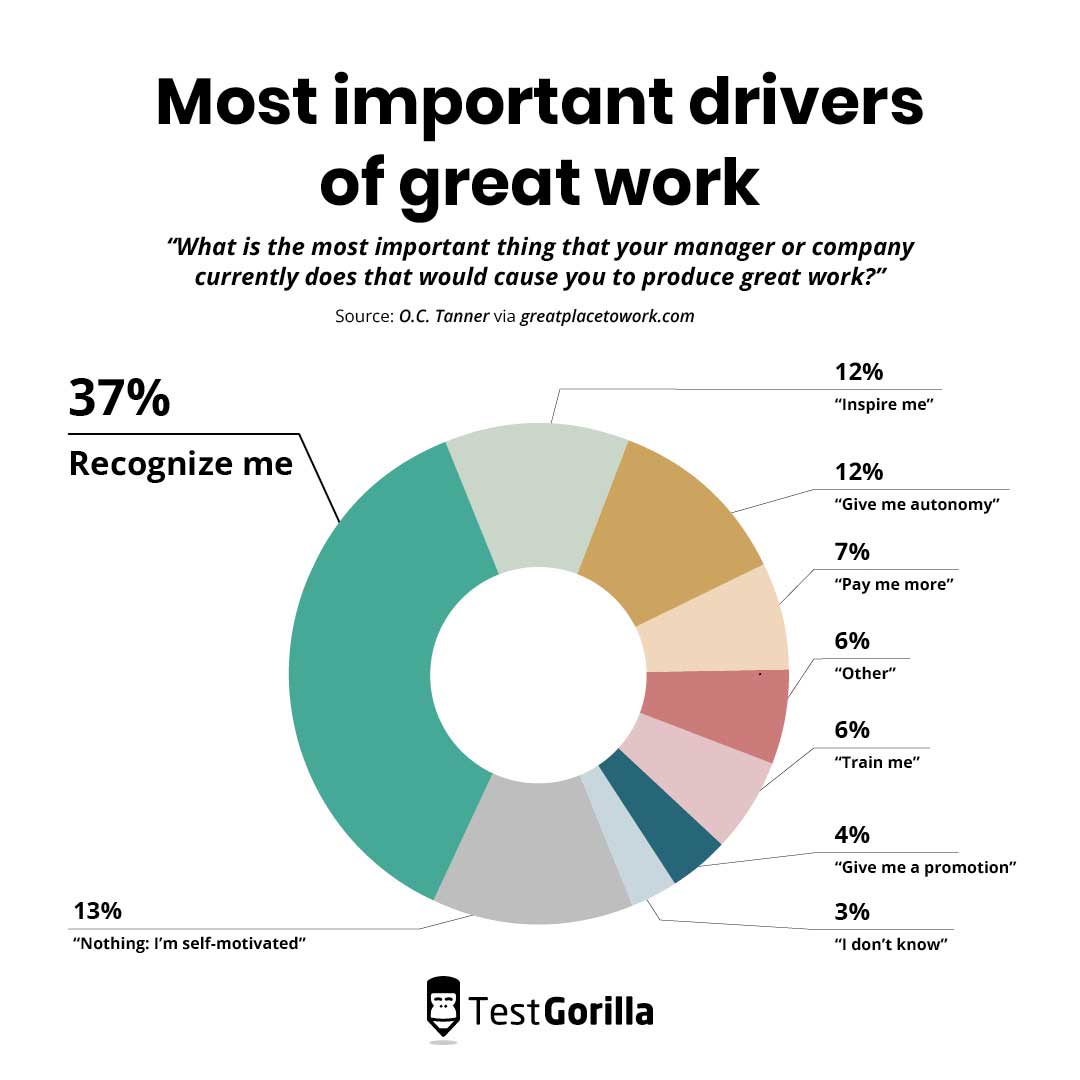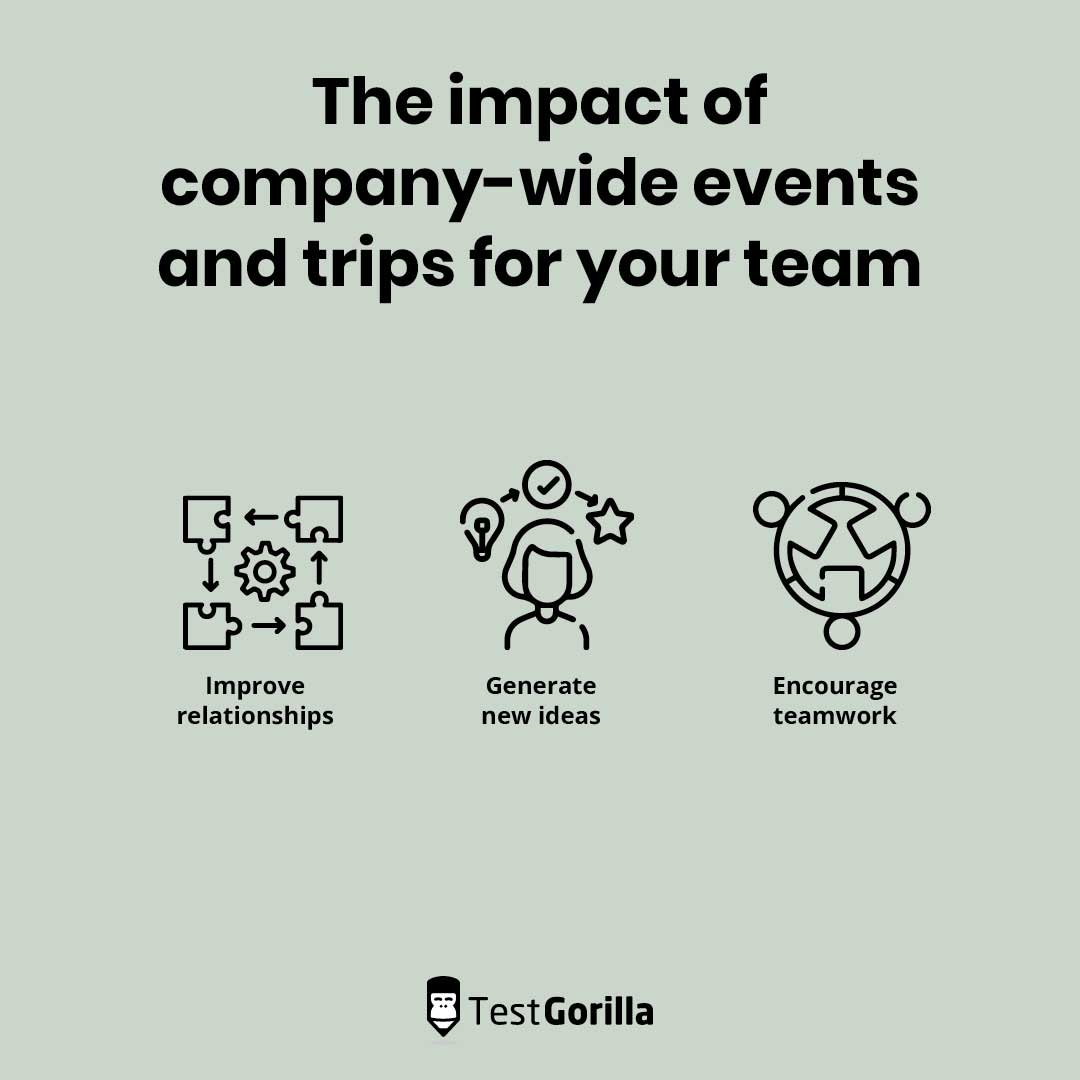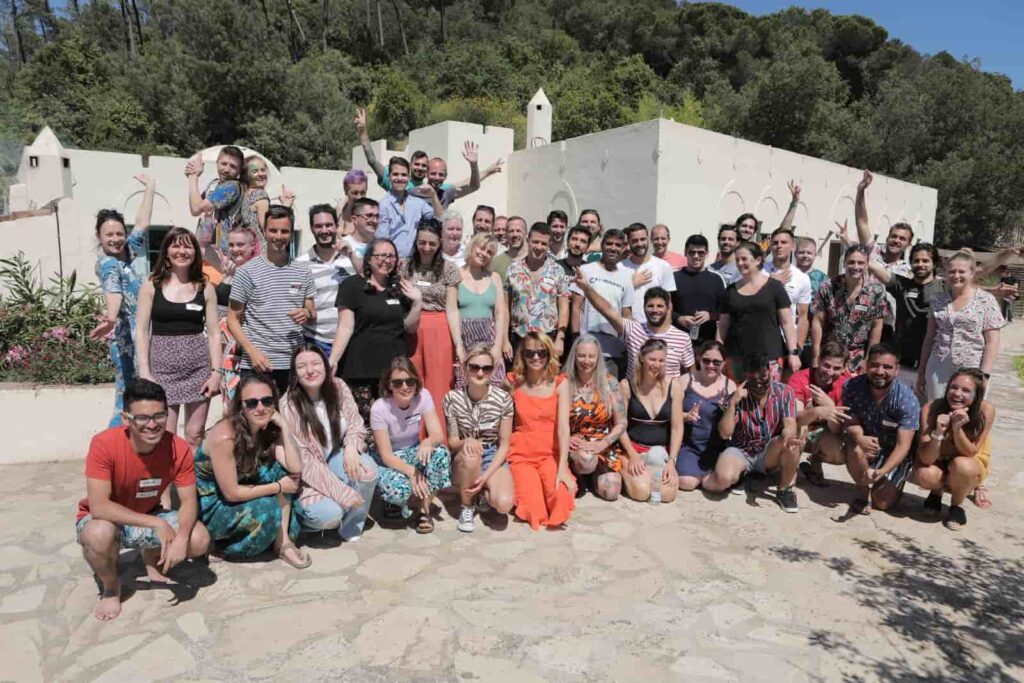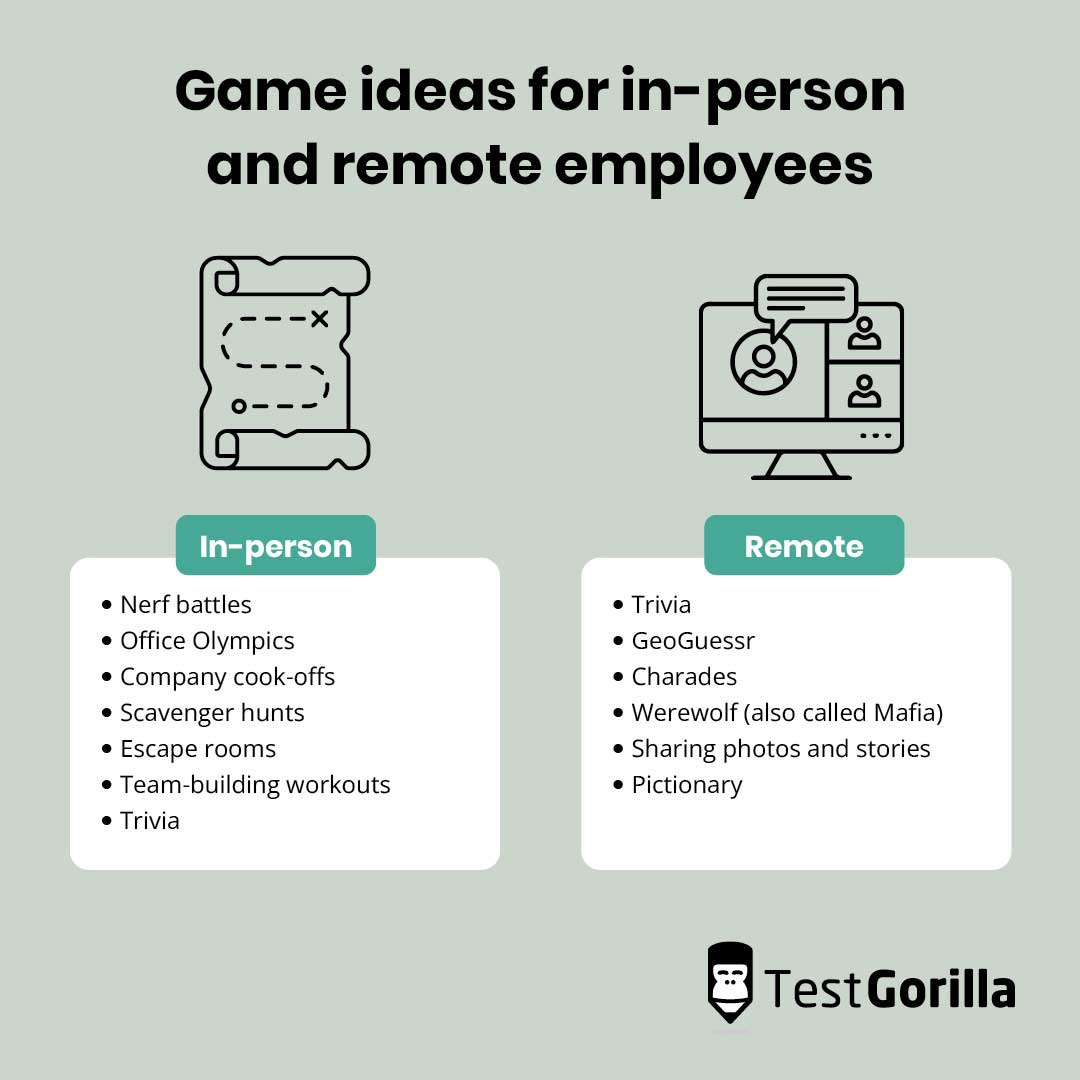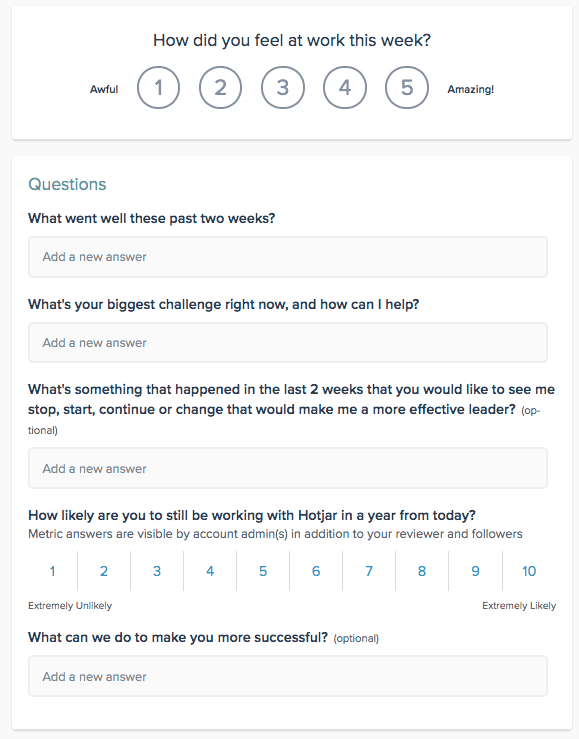High employee morale is directly linked to increased engagement and motivation, which lead to greater work effort.[1] This, in turn, translates to higher performance and productivity.
This cause-and-effect chain means that boosting your staff morale also:
Improves the quality of work and efficiency
Increases job satisfaction and retention rates
Reduces employee burnout
It’s no wonder HR professionals everywhere are interested in finding fun ways to boost morale at work.
Staff morale boosters range from short and sweet coffee breaks to annual company-wide team-building events and trips.
So how will you decide which morale boosting activities are best for your employees, business, and work style?
Find inspiration by taking a look at our nine favorite company morale boosters and why they work as well as they do. As a bonus, we’ll show you how we use these activities to keep our staff motivated here at TestGorilla.
Table of contents
Our favorite fun ways to boost morale at work
Improving employee morale and motivation is necessary for a healthy, efficient business, but every company does it a little bit differently.
Below, we’ve listed our top staff morale boosters so that you can choose what suits your organization best.
Summary of the 9 morale boosting strategies
Strategies | Description |
1. Express gratitude to your employees | Recognition and gratitude are some of the top staff morale boosters |
2. Hold company-wide team-building events once or twice a year | Company-wide trips and events nurture relationships and increase motivation |
3. Provide healthy food options and encourage meal breaks | Providing employees with healthy food options and promoting a culture of taking real breaks improves performance and satisfaction |
4. Hold office games and competitions | Games between team members foster healthy relationships and help engage and motivate employees |
5. Listen to employee feedback and take action based on it | Taking the time to listen to employee feedback and actively implementing it can make employees feel seen and valuable |
6. Celebrate achievements and failures alike | Promoting a work culture of celebrating wins and not dwelling on failure boosts morale and creates a supportive atmosphere |
7. Allow flexible working and a more relaxed dress code | Flexible working arrangements and a relaxed dress code give workers the autonomy they crave |
8. Set up a “coworking call” team members can drop in and out of when they want | “Virtual watercooler” programs help remote teams connect and increase productivity |
9. Add a nap room to let employees take a short break | Nap rooms and nap allowances help employees get much-needed rest and improve the quality of their work |
1. Simply express gratitude to your employees
Nothing can take the place of earnest gratitude and recognition. Simply telling your employees they do good work can be more meaningful than many tangible and monetary rewards.
Gratitude can take many forms, from informal group chat shout-outs on Slack all the way to formal award ceremonies.
Numerous reports and studies have shown the importance and impact of recognition. Its presence drives employee satisfaction and engagement, and its absence increases turnover.
An employee survey by O.C. Tanner found that recognition was the biggest driver for engagement and performance.
According to another study, teams perform better and more productively when team members believe that their coworkers appreciate them, showing the power of peer-to-peer recognition.
At TestGorilla, we thoroughly agree that praise and gratitude are vital – and we practice what we preach.
On the informal side, we like using the HR platform Bob’s “kudos” feature to recognize good performance. This enables peers and leaders alike to easily celebrate others’ successes whenever they happen.
On the more formal end of the spectrum, TestGorilla reserves 10 minutes each week in our company-wide standups for folks to do shout-outs across the organization.
How do you implement recognition in your company?
Our top three tips are:
Make it easy: Making it simple to give praise and gratitude is a good idea. We’re all busy, so the easier something is, the more often we’ll do it.
Make it frequent: One of HBR’s top tips for employee appreciation is building recognition into your routine so that employees get to hear they’re appreciated often.
Make it a part of the company culture: You can facilitate the last two tips by simply nurturing a company culture based on gratitude and appreciation.
A positive workplace culture founded in kudos and recognition will normalize the regular practice of gratitude for everyone at your organization, whether it’s between managers and team members or even peer to peer.
2. Hold company-wide team-building events once or twice a year
Large company-wide events, like trips or charity work, are great for improving employee morale and motivation and help create a greater sense of loyalty and belonging.
Events like these are relatively few and far between, occurring maybe once or twice a year. However, they can have a memorable impact when they do happen.
This is especially true for remote and hybrid office workers, who have few chances to connect to their colleagues in a meaningful way.
Company-wide events and trips affect your team in many ways:
Improve relationships: Interacting with your colleagues outside of work helps you develop a better understanding of each other and enriches relationships
Generate new ideas: Getting a different perspective opens the door for fresh opinions and ideas, refreshing creativity
Encourage teamwork: Co-operating on something other than the same projects you work on from nine to five renews your employees’ sense of teamwork
These benefits lead to stronger employee engagement and motivation.
TestGorilla holds an annual event for our team. Last June, we went to Barcelona, Spain.
The trip had work-related activities like speeches from the C-suite and department sessions, which included an ask-me-anything for the marketing team with the new head of marketing.
A few activities were just for fun, like a scavenger hunt around the city, guided active meditation, a sailing event, and a pool party. We also had an LGBTQIA night out organized by our co-founder.
Of course, there were a lot of delicious dinners, too!
How do you implement team-building events in your business?
Planning a team-building event can be a lot like a company project, so we recommend:
Choosing an event theme (charity, travel, etc.)
Setting a budget
Establishing a realistic timeline
Getting the right people together to pull it off
Involving other businesses as needed, such as catering and entertainment companies
Huge events like this are a big undertaking, which is why we suggest holding them only once or twice a year or for large celebrations.
3. Provide healthy food options and encourage meal breaks
Employees are human beings, and nothing quite boosts morale like real, satisfying food.
It’s logical that healthy, nourishing food helps the body and mind, increasing productivity and positivity toward work.
You can facilitate these benefits by providing healthy food and drink options as perks and promoting a culture where people take the time to savor their well-anticipated breakfast, lunch, or dinner breaks – no stuffing down a sandwich at their desk in a matter of seconds.
Real meal breaks enable employees to refuel their bodies patiently, relieving stress and anxiety and giving them a much-needed energy boost.
The work management tool company Asana serves breakfast, lunch, and dinner at its offices, so food is always available to employees regardless of shift.
The business strives to source organic ingredients and make recipes that include fresh vegetables, healthy fats, and natural sweeteners.
Leandra Rouse, a culinary nutritionist, says the food she recommends to organizations like Asana directly benefits employees’ performance and productivity. For example, the company serves brain-supporting foods before a big launch or protein and complex carbs for breakfast to support all-day energy.
How do you implement morale boosting meals in your organization?
Here are a few of our favorite recommendations to improve employee morale with food and drink:
Have a day of the week when everyone orders lunch at the office and eats together
Hire a food truck once a week to serve food in the office
Organize a virtual meal room once a week for remote workers
Use gentle lighting and quiet music in the break room to make meals a desirable, relaxing time
Lead from the top and encourage management to take real breaks with real food
Food is a necessary part of life. The sooner your employees realize that and prioritize it, the sooner they can tackle the rest of their day with the vigor and motivation it needs.
4. Hold office games and competitions
Nothing quite gets the creative juices flowing like a game or competition. They’re engaging, exciting, and bonding.
Office games aren’t exclusive to in-office employees, either. You can hold many fun events over Zoom video conferences for remote workers.
Here are a few game ideas for in-person and remote employees:
In-person ideas | Remote ideas |
Nerf battles,
Office Olympics, Company cook-offs, Scavenger hunts, Escape rooms, Team-building workouts, Trivia | Trivia, Geo, Guessr, Charades, Werewolf (also called Mafia), Sharing photos and stories, Pictionary |
Games and competitions are some of the most fun ways to boost employee morale. They encourage teammates to involve themselves in non-work projects, nurture new relationships, and show off skills they usually only use at home.
TestGorilla holds a rotating event every Wednesday that’s organized by a different team member each time, so we get to try a variety of morale boosting activities.
We’ve done pub quizzes, played GeoGuessr, and even got our blood pumping in a 1980s-inspired aerobics workout and stretching session with the corporate well-being company Good Stretch.
And that’s not all. Our marketing team holds a “First Fridays” team social in which one person hosts and we all play a game. So far, we’ve played charades, truth or dare, Gartic Phone, and Werewolf.
These morale boosting team-building activities have helped us build camaraderie and bond as a team as our business grows. This enables us to maintain solid relationships and core values that continue to make our business a place where people want to work.
How do you implement games in your company?
We recommend choosing a different employee to host and pick a game each week. This personally involves your team and immerses them in the game, engaging them and making them feel valued.
You’ll also get to play a diverse range of games depending on what the individual chooses. It’s a great opportunity for them to show off their unique interests and the perspectives they bring to the table.
5. Listen to employee feedback and take action based on it
Next to international trips and group games, feedback may seem a little insignificant when it comes to team morale boosters.
However, listening to and implementing feedback makes employees feel connected and valued.
Collecting employee feedback helps your people feel listened to and cared for. It improves their opinion of the business and shows them they’re working for real people and not a faceless company.
Hotjar, a provider of digital user behavior and feedback-tracking services, walks the talk. It implements a five-part feedback system, which includes bi-weekly employee pulse surveys.
These pulse surveys are simple yet yield actionable insights by using a combination of straightforward and open-ended questions.
This model serves the company well, encouraging its employees to invest in its operations and culture and engage more deeply with their work.
How do you implement active employee feedback in your business?
One of the best ways to implement this practice is to ensure that you show employee feedback loudly and proudly. You want them to see that you are using their ideas.
Try making a channel on your group chat just for employee suggestions that management has put into action. A live variation of this is holding monthly meetings in which leaders address questions and suggestions that employees voted on.
A company with a culture rich in two-way feedback is continuously learning and improving. It’s a safe space to develop and feel valued.
Rich, constructive feedback is a great way to build more empathy in the workplace.
6. Celebrate achievements and failures alike
Recognizing achievements and success seems like an obvious choice when it comes to employee morale boosters.
But if it’s obvious, why don’t more employers do it? Often, it’s simply an oversight or an area of negligence.
One study showed that an unfortunate 29% of healthcare workers receive no recognition of any kind.[2] This is especially demoralizing in a field where failure can be devastating for workers’ mental health, so the balance granted by honest recognition can be much-needed.
It’s important to take the time to celebrate wins and successes with your people. Achievements like deals won, projects completed, and product launches shouldn’t fly under the radar without the recognition they deserve.
This also goes for birthdays and work anniversaries.
Oddly enough, celebrating failure can be another fun way to boost morale at work.
Owning up to mistakes and laughing them off encourages a healthy relationship with failure. It builds a culture where it’s okay to fail and people aren’t chastised for doing so.
Building a space where failure isn’t the “end of the world” skyrockets morale and encourages employee accountability.
How do you recognize wins and failures in your organization?
For small achievements, give your employees recognition and praise via virtual kudos on your company’s group chat program. Try creating a channel just for celebrations and shout-outs.
For slightly larger successes or team achievements, try throwing a staff party, ordering everyone lunch, or putting up a group recognition post on your company’s social media, like LinkedIn.
Drew Farber, a contract copywriter, used LinkedIn to celebrate his team after their teaser trailer won a Clio Award.
To celebrate failure, create a “fail of the week forum” and encourage employees to share their own errors, mistakes, and silly moments.
You can lead from the top by having leaders and managers post on this channel. This shows employees that leaders not only make mistakes but recognize them and don’t think of themselves as perfect.
7. Allow flexible working and a more relaxed dress code
Employees want more autonomy in how they get their work done. Two big ways to give that to them are:
A more flexible schedule
More control over what they wear
Worker autonomy is a popular trend in the business world, with employees wanting (and in many cases needing) more control of how, when, and where they do their work.
But it isn’t just what employees want; it helps your business, too.
Flexible working arrangements let employees work when they’re most energetic and productive, enabling them to rest when needed.
Looser dress codes also increase productivity and performance. One study found that 61% of employees would be happier and more productive without a strict dress code.[3]
The same study also found that job seekers are more likely to negatively perceive companies with a dress code, which means that a dress code affects your hiring strategy.
How do you implement a flexible working policy and a more relaxed dress code in your company?
Try creating a flexible working policy that allows workers to choose different working arrangements, such as:
Remote work
A hybrid office
A compressed workweek
These types of working arrangements are particularly useful for working parents, students, employees with multiple jobs, and those with alternative lifestyles.
To implement a looser dress code, try starting small with a “Casual Friday” or “Casual Saturday” on which you reduce dress requirements. If this goes well, it may be a good idea to take it further and allow casual wear every day of the week.
8. Set up a “coworking call” team members can drop in and out of when they want
Many businesses are helping remote teams stay connected through “coworking calls.”
Companies like Donut and Cosmos facilitate a video conference that employees can drop in and out of whenever they like just to see who’s there, share a coffee, or chat.
These channels can be for teams, entire departments, or even the entire company.
A virtual water cooler might be just the thing remote workers need to stay motivated, build relationships, and combat working-from-home depression.
These platforms encourage remote collaboration and socialization and help workers get the answers they need quickly.
It’s great for body doubling, the practice of working alongside someone else to help boost productivity and performance, which is especially useful for neurodivergent folks.
How do you implement a virtual water cooler in your business?
A simple version of this is a group chat channel specifically for water cooler talk. However, going all the way and grabbing one of the above tools is especially helpful.
Setting up a casual coworking call helps beat the isolation of working from home and is one of the most fun ways to boost morale at work for remote employees.
9. Add a nap room to let employees take a short break
Just as food and nutrition are human necessities, so is sleep. Sleep fuels our energy, productivity, and performance each and every day.
However, your brain is sometimes too foggy to continue functioning at peak performance.
Quality of sleep has taken a serious hit since the pandemic.[4] That’s why workers need midday rest to boost performance and work quality.
Adding a nap room to your office and allowing employees to drop in for a quick 10 to 15 minutes improves the quality of work and engagement. It also goes that extra step of enhancing your employees’ opinion of the workplace.
Research suggests that midday naps benefit[5]:
Concentration
Mood
Memory
Creativity
Some workers need this boost so badly that they sneak off to take a nap without the company’s permission or knowledge.
In fact, 22% of working Americans nap during the workday to refresh their minds and ensure they stay productive.[6]
Your business would be far from the first to implement a nap room – big organizations, including Google, Zappos, and Ben & Jerry’s, have already seen great success with it.
When it comes to Ben & Jerry’s dedicated nap space, a company representative says that it cares about its employees’ quality of life. They go on to say that providing space and time for sleep is just another way it takes care of its people.
How do you implement a nap room in your organization?
Try blocking off a conference room for a few hours a day as a “nap space.” For example, you can designate 2:00 PM to 4:00 PM as nap hours for employees to go in and rest.
Be sure to set guidelines surrounding the length of the nap. Most experts recommend 10 to 20 minutes.
What about remote workers?
Implement an allowance system (or simply a no-questions-asked short break) for work-at-home employees so that they can take a power nap on their bed or sofa.
Try a few of these fun ways to boost morale at work
Morale is essential for a well-functioning business. It improves motivation, engagement, and overall employee satisfaction. So there’s no reason not to try a handful of these methods in your workplace.
Give out more kudos, play an office game with your team, or have a group lunch break once a week to give you a chance to talk, laugh, and share.
Staff morale boosters aren’t just beneficial to your current workers. They improve your business as a whole and make it a solid place to work.
If you’re looking for more ways to improve your organization, read our blog posts on the top job satisfaction factors or how to assess your organizational culture.
To further promote your organization’s values and culture, assess your next new candidate with our Culture Add test.
Sources
Bailey, Catherine; Madden, Adrian; Alfes, Kerstin; Fletcher, Luke; Robinson, Dilys; Holmes, Jenny; Buzzeo, Jonathan; Currie, Graeme. (June 2015). “Evaluating the evidence on employee engagement and its potential benefits to NHS staff: a narrative synthesis of the literature”. National Center for Biotechnology Information. Retrieved November 29, 2022.
Saunderson, Roy. (June 16, 2016). “How Frequently Should You Give Recognition?”. Authentic Recognition. Retrieved November 29, 2022.
“New study: Your dress code could be putting off employees…”. (December 20, 2016). Stormline. Retrieved November 29, 2022.
Marvaldi, Maxime; Mallet, Jasmina; Dubertet, Caroline; Moro, Marie Rose; Guessoum, Sélim Benjamin. (March 24, 2021). “Anxiety, depression, trauma-related, and sleep disorders among healthcare workers during the COVID-19 pandemic: A systematic review and meta-analysis”. PubMed. Retrieved November 28, 2022.
Brody, Bob. (February 25, 2022). “Why napping at work can make you better at your job”. Fast Company. Retrieved November 28, 2022.
“New Better Sleep Council Research Reveals 22% of Working Americans Nap During the Workday”. (August 5, 2021). The Better Sleep Council. Retrieved November 28, 2022.
Related posts
Hire the best candidates with TestGorilla
Create pre-employment assessments in minutes to screen candidates, save time, and hire the best talent.
Latest posts
The best advice in pre-employment testing, in your inbox.
No spam. Unsubscribe at any time.

Hire the best. No bias. No stress.
Our screening tests identify the best candidates and make your hiring decisions faster, easier, and bias-free.
Free resources
This checklist covers key features you should look for when choosing a skills testing platform
This resource will help you develop an onboarding checklist for new hires.
How to assess your candidates' attention to detail.
Learn how to get human resources certified through HRCI or SHRM.
Learn how you can improve the level of talent at your company.
Learn how CapitalT reduced hiring bias with online skills assessments.
Learn how to make the resume process more efficient and more effective.
Improve your hiring strategy with these 7 critical recruitment metrics.
Learn how Sukhi decreased time spent reviewing resumes by 83%!
Hire more efficiently with these hacks that 99% of recruiters aren't using.
Make a business case for diversity and inclusion initiatives with this data.

